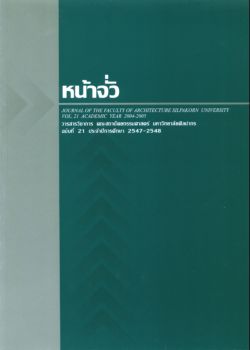แนวความคิดในการอนุรักษ์โบราณสถานจากศตวรรษที่ 18 ถึงสิ้นศตวรรษที่ 20: จากอารมณ์และความศรัทธาสู่ความเป็นมรดกร่วมกันของมนุษยชาติ
คำสำคัญ:
แนวความคิดในการอนุรักษ์ศตวรรษที่ 18 - 20, Conservation concepts the 18"–20" centuryบทคัดย่อ
แนวความคิดในการอนุรักษ์โบราณสถานในฐานะที่เป็นสิ่งมีคุณค่าเป็นเรื่องที่มีมานานแล้วในยุโรป แต่จํากัดอยู่เฉพาะในกลุ่มคนส่วนน้อย แนวความคิดนี้แพร่หลายมากขึ้นตั้งแต่ศตวรรษที่ 18 เมื่อเกิดการปฏิวัติอุตสาหกรรมขึ้นในยุโรป ในศตวรรษที่ 19 มีการต่อสู้กันทางความคิดว่าการอนุรักษ์โบราณสถานควรที่จะเน้นที่การสร้างให้โบราณสถานมีรูปแบบสมบูรณ์ ตามอุดมคติหรือจะรักษาลักษณะที่มันเป็นอยู่จริงเพื่อรักษาข้อเท็จจริงทางประวัติศาสตร์ สงครามใหญ่ที่เกิดขึ้นหลายครั้ง ในศตวรรษที่ 20 และทําลายโบราณสถานย่อยยับไปเหลือคณานับ ทําให้เกิดความเคลื่อนไหวที่จะสร้างอุดมการณ์ร่วมกัน ระดับนานาชาติว่าโบราณสถานเป็นมรดกวัฒนธรรมร่วมกันของมนุษยชาติที่ทุกคนควรจะปกป้อง เรื่องนี้เริ่มก่อตัวเป็นจริงขึ้น หลังสงครามโลกครั้งที่ 2 เมื่อมีการจัดตั้งองค์การศึกษาวิทยาศาสตร์และวัฒนธรรมแห่งสหประชาชาติ (UNESCO) 1946 UNESCO ได้ช่วยเหลือให้มีการประชุมนานาชาติของสถาปนิกและผู้เชี่ยวชาญการอนุรักษ์ครั้งสําคัญขึ้น ที่นครเวนิสประเทศอิตาลี ในปี ค.ศ.1964 ผลการประชุมได้กลายมาเป็นหลักการสําคัญของการอนุรักษ์สากลที่เรียกกันว่า “เวนิสชาร์เตอร์” ในปีเดียวกัน นั้นเอง UNESCO ได้ผลักดันให้เกิดสภานานาชาติว่าด้วยอนุสรณ์สถานและที่ตั้ง (ICOMOS) ขึ้นเพื่อการสร้างโครงข่ายการอนุรักษ์ระดับโลก โดยยึดถือหลักการของเวนิสชาร์เตอร์เป็นแนวทางปฏิบัติ ปลายศตวรรษที่ 20 หลายประเทศเริ่มมีคําถามเกี่ยวกับอุดมการณ์สําคัญของเวนิสชาร์เตอร์ที่ว่าด้วยการอนุรักษ์ “ความเป็นของแท้” ของโบราณสถานว่าเหมาะสมกับวัฒนธรรมอันหลากหลายของโลกเพียงไร ข้อกังขานํามาสู่การประชุมครั้งสําคัญ ว่าด้วยความเป็นของแท้ ที่เมืองนารา ประเทศญี่ปุ่น ในปี ค.ศ.1994 ผลการประชุมถูกจัดทําเป็นเอกสารแห่งเมืองนารา ว่าด้วยความเป็นของแท้ซึ่งมีใจความสรุปว่า ทุกชาติควรยึดมั่นในกฎเกณฑ์นานาชาติและเคารพในวัฒนธรรมการรักษา โบราณสถานของตนเองไปพร้อมกัน โดยให้ยืนอยู่กับความจริงและสร้างสมดุลระหว่างวัฒนธรรมสากลและวัฒนธรรมท้องถิ่น
The Concepts of Architectural Conservation From the 18" to the End of the 20° Century: From Sentiment and Faith to the Shared Heritage of Humankind
The idea of conservation of ancient monuments as valuable heritage was conceived in Europe since ancient times but known only among intellectuals. It became widespread in the 18th century when the industrial revolution took place. There was a theoretical argument in the 19th century over whether the monuments should be restored to their perfect glory or be left untouched to preserve their authenticity. Wars in the 20" century destroyed innumerable monuments. This led to a movement to protect ancient monuments perceived as common heritage of humankind. Activities began materializing after the Second World War when UNESCO was found in 1946. This was followed by a conference of major significance in Venice in 1964 supported by UNESCO which resulted in the Venice Charter as the reference tool for conservation of ancient monuments throughout the world. In the same year UNESCO also assisted the establishment of ICOMOS which aimed at creating an international network for conservation. By the end of the 20" century many countries questioned the principal idea behind the Venice Charter on the preservation of “authenticity” as to whether it was appropriate for the cultural diversities of its members around the world. This brought about another significant meeting at Nara in 1994 which concluded that each nation should adhere to international charters yet respect the local conservation custom and create a balance between the requirements of local culture and that of the international community.





